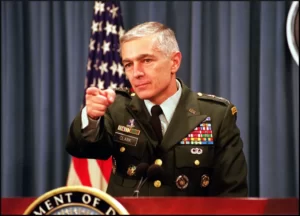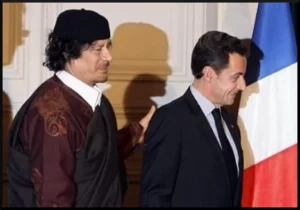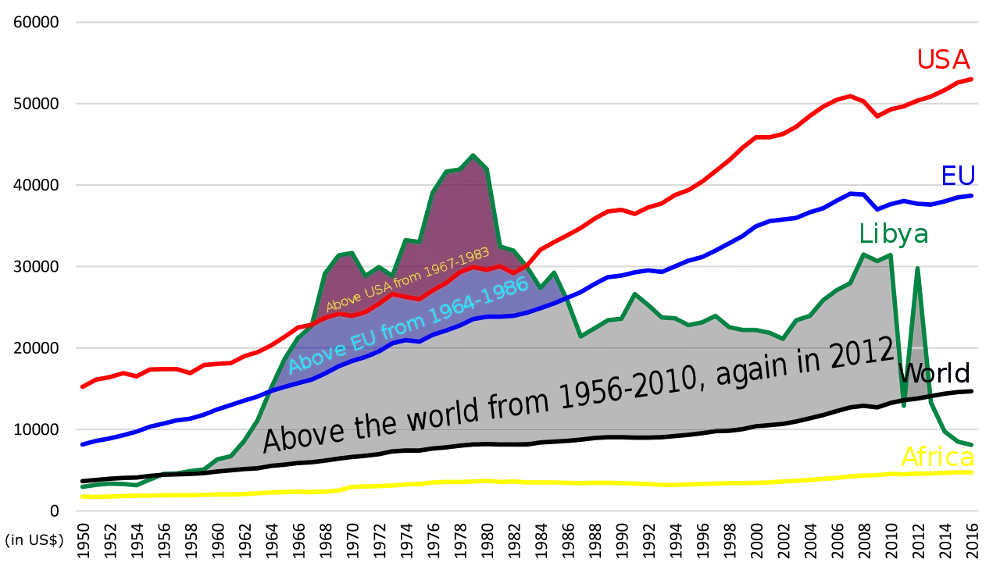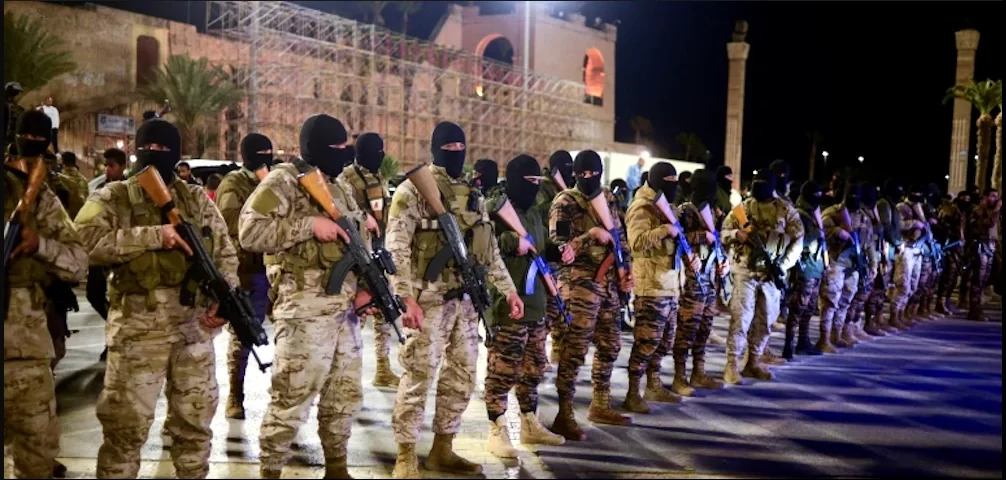by Shane Quinn, published on Global Research, March 19, 2022
Eleven years ago, on 19 March 2011, the United States and its military arm NATO unleashed a sustained bombardment against Libya, where Colonel Muammar Gaddafi had been in charge for over four decades. Gaddafi would be killed in brutal fashion seven months later, while Libya descended into chaos as warring parties in this fractured country turned on each other.
The US-NATO invasion of Libya was not restricted to air raids. In the opening hours of the attack, American and British war ships and submarines fired scores of cruise missiles which, by 21 March 2011, had wiped out Gaddafi’s entire strategic air defence system along the Libyan coastline. US B-2 spirit bombers destroyed Libya’s largest airport, in the capital Tripoli, while Tornado aircraft launched Storm Shadow missiles at numerous strategic targets.
Gaddafi’s critical mistake “was to give up his nuclear weapons agenda”, as noted by prominent Indian historian Vijay Prashad (1). In a deal with the Western powers, Gaddafi had abandoned the enrichment of uranium for nuclear bombs, while sanctions were lifted on Libya. Various nations, including Iran and North Korea, informed Gaddafi that it was a serious error to weaken his defences and pursue overtly friendly relations with the West.
Hawkish Bush administration official John Bolton had explicitly warned Libya, Iran and Syria on 5 April 2003 that the US attack on Iraq “sends a message” to those countries, conveying that “the cost of their pursuit of weapons of mass destruction (WMD) is potentially quite high”. (2)
Early this century, Iraq had of course no nuclear or biological weapons, as was known before the March 2003 US invasion began. Saddam Hussein was just as defenceless as Gaddafi would be eight years later, both ideal targets in nations which, by no coincidence, possess major oil sources and lie in strategically important regions. The lesson is stark and ugly – if one wishes to be secure from attack by the imperial powers, turn one’s country into a nuclear state or military fortress.
Following nine months of negotiations, on 20 January 2004 president George W. Bush said that Gaddafi had “correctly” committed himself to “voluntarily” liquidating his WMD programs. More than 10 facilities in Libya were dismantled where uranium enrichment had been taking place for nuclear bombs. Gaddafi’s biological weapons arsenal was also destroyed.
In 2005, some of the largest US and British oil corporations flocked to Libya such as ExxonMobil, Chevron and British Petroleum (BP). That year they set up the US-Libya Business Association; this rosy relationship, however, was not as it seemed.

Washington’s planned removal of Gaddafi dated to the first term of George W. Bush’s presidency, part of his global “pro-democracy campaign”. Like Bashar al-Assad of Syria, Gaddafi was displaying too much independence and disobedience. After invading Afghanistan in October 2001, Bush intended to attack 7 other countries in 5 years, those being: Iraq, Libya, Syria, Iran, Somalia, Sudan and Lebanon. This was revealed by ex-NATO commander Wesley Clark, in comments he made in an interview on 2 March 2007. Rather tellingly, Clark stressed later on, “Obama’s invasion of Libya was planned under the Bush administration, Syria is next”. (3)
Long before intervening militarily in Libya, the new president Barack Obama had ordered that the US Treasury Department freeze the accounts of Gaddafi’s state-owned Libyan National Oil Corporation, including the seizure of $30 billion. According to the IMF, Gaddafi further had 143.8 tons of gold, worth over $6.5 billion, deposited as international reserves in 25 countries. These funds were likewise frozen by the Americans (4). In sanctions imposed on Libya through the UN Security Council, the US-NATO partnership appropriated the Sovereign Wealth Funds (SWF), in which Libya had invested abroad as an oil-exporting country.
Any unrest in Libya was a domestic issue. Gaddafi was not threatening to invade other countries, unlike the NATO organisation, nor was he a menace to international security. He had no nuclear or biological weapons, and did not even have at his disposal a large and well-trained army. Three months after the US-NATO invasion of Libya his son, Saif al-Islam Gaddafi, said in an interview that Libya made crucial errors in its neglection of constructing a proper army, along with having “delayed buying new weapons, especially from Russia”. He went on, “Our example means one should never trust the West and should always be on alert. We thought Europeans were our friends; our mistake was to be tolerant with our enemies”. (5)
North Korea learnt the hard way long ago. In the early 1950s, their country had been levelled by US Air Force bombing raids. The Kim Dynasty thereafter armed the country to the teeth. Even so, president Bill Clinton almost ordered an attack on North Korea during the summer of 1994. What ultimately deterred the Americans was the might of North Korea’s military, and consequently the Pentagon’s grim prediction that such an invasion would result in perhaps a million deaths (6). In the event of a US attack, North Korea’s generals would have retaliated by decimating the South Korean capital Seoul with the full force of its arsenal, positioned just 50 miles or so away.
As soon as the rebellion started in early 2011 in Benghazi, Libya’s second largest city, anti-Gaddafi insurgents advised by British and French special forces attempted to capture Libya’s oil refineries, located in the north and north-east of the country. Vicious battles were subsequently fought around these oil installations. Almost immediately, a leading goal of the Western powers was revealed: retaining control over Libya’s oil, using proxy fighters.
A group of special forces from the Netherlands, a NATO and EU nation, had been captured by Gaddafi’s troops in Sirte, northern Libya, on 27 February 2011. Three days later, 400 US soldiers from the 24th Marine Expeditionary Unit, and also the Marine Air Ground Task Force (MAGTF), landed in Crete, just 300 miles from the Libyan coastline. Major Carl Redding, spokesman for the US Marine Corps, said that these troops had been dispatched “as part of our contingency planning to provide the president flexibility on a full range of options regarding Libya”. (7)
In the weeks before the March 2011 invasion, elite personnel from the triumvirate of America, Britain and France were present on Libyan soil. This included everything from CIA advisors and US Navy SEALs, to MI6 spies and British SAS soldiers, along with French secret agents. (8)
To ensure the toppling of Gaddafi, the Western powers were collaborating with terrorists of the Libyan Islamic Fighting Group (LIFG), whose members included such men as Abu Yahya al-Libi. He belonged to the highest echelon of Al Qaeda. The LIFG was centrally involved in the anti-Gaddafi revolts. US-NATO were furnishing Al Qaeda factions in North Africa with arms, equipment and intelligence support, while the LIFG itself was closely aligned to Al Qaeda. The uprising against Gaddafi was, actually, being led on the ground by extremists who had previously fought against the US Army in Afghanistan and Iraq, and were now being supported by the West in Libya.
Brazilian professor Moniz Bandeira wrote that,
“The rebels who were hailed as so-called freedom fighters were, in fact, mujahidin, radical Islamists who participated in the war against the United States in Afghanistan and in Iraq, and returned to Libya, probably with the backing of Saudi Arabia and Qatar”. (9)
On 23 December 2010 three anti-Gaddafi insurgents arrived in Paris: Ali Ounes Mansouri, Farj Charrant and Fathi Boukhris. They joined forces with Gaddafi’s former intelligence chief, Nuri Al-Mismari, along with the French military, so as to organise the movement to oust Gaddafi. Together with the Libyan rebel commander Ali al-Hajj, these men had a part in igniting the February 2011 uprising in Benghazi.
In early 2011, the Al Qaeda chief Ayman al-Zawahiri dispatched veteran terrorists to Libya, so as to establish a foothold there (10). The uprising in Libya was supported strongly by Osama bin Laden, who was delighted to see his “Libyan brothers” wage jihad on Gaddafi.

The French president Nicolas Sarkozy, who was influencing the insurgents in Libya before the NATO attack, said in late February 2011 that “Mr Gaddafi must leave” (11). Sarkozy knew he could rely on US support, and Obama echoed Sarkozy’s comments a week later.
Why were Sarkozy and Obama publicly demanding that Gaddafi should go? Another reason may be that, in 2009, the French energy multinational Total SE was forced to accept significantly reduced terms, pertaining to its oil and gas production initiatives in Libya. This was also the case with the US oil firms, Chevron and Occidental Petroleum, whose contracts with Libya’s National Oil Corporation were scaled back in 2009. WikiLeaks documents revealed that Total SE and other Western energy companies were entitled to only 27% of oil production in Libya, a sizable fall (12). Moreover, the West’s cut of gas production was reduced to 30%, instead of the 50% they had been granted in previous contracts.
Living conditions in Gaddafi’s Libya, just before the US-NATO bombardment began, are revealing and interesting. The 2010 UN Human Development Report, published in November of that year, expounded that overall living standards in Libya were quite good – and easily the highest in Africa. UN studies for 2010 ranked Libya in 53rd place out of the world’s 194 countries on the Human Development Index (13). This placed Libya towards the top end of the High Human Development bracket, and just outside Very High Human Development.
Quality of life in Libya – based on annual income, schooling, average life expectancy, etc., – showed that Libyans were better off than people resident in major countries like Brazil, Turkey, China and India. The average yearly wage earned by a Libyan in 2010 was larger by comparison to either the typical Brazilian, Turk or Chinese. This is not to suggest that Libya was a paradise under Gaddafi. One in five Libyans was illiterate, mainly those in the country’s numerous and complex indigenous groups, who placed a barrier between themselves and Gaddafi’s government; there were problems with unemployment in the country, and the poorest suffered from a lack of access to adequate housing. (14)

Yet at the end of Gaddafi’s reign, living standards in Libya were superior furthermore in comparison to a number of European countries, such as Bulgaria, the Ukraine, Belarus, Serbia and Albania. Gross Domestic Product (GDP), though not often an accurate indicator of human welfare, had increased by a remarkable 16.6% in Libya during 2010 alone (15). The supposed universal suffering of Libya’s six million people under Gaddafi falls apart on closer inspection.
Having toured Libya and its capital Tripoli in May 2001, Fidel Castro was correct later on when he wrote in early March 2011,
“In contrast with what is happening in Egypt and Tunisia, Libya occupies the first spot on the Human Development Index for Africa, and it has the highest life expectancy on the continent. Education and health receive special attention from the State”. (16)
The real hardships for the Libyan populace began with the US-NATO assault. By the end of 2011 Libya’s UN Human Development ranking fell by more than 10 places, to 64th. (17)
By 2015 Libya had dropped to 94th and four years later, at the end of 2019, the country was placed a lowly 105th on the Human Development Index (18). This constitutes a fall of more than 50 places in less than a decade, as Libya witnessed one of the biggest declines in living standards recorded globally; and due in large part to NATO’s “humanitarian intervention”.
Just 10 days into the US-NATO attack, by 29 March 2011 the Americans had already spent $550 million in the effort to dislodge Gaddafi. Through ostensibly outsourcing the war to NATO, Washington could deny accountability, and in the background apply the full measure of its economic and military power. Bandeira noted that what the Obama administration and its allies “really wanted was regime change in Libya” while
“the United States continued to spend $10 million each day to sustain the operations, using drones, the unmanned aircraft guided by the CIA, and committing war crimes and human rights violations through the bombing and massacre of civilian populations, such as those that occurred in Sirte [northern Libya] and several other cities”.
NATO warplanes especially targeted Sirte for bombing, located near much of the country’s known oil reserves. By the end of the invasion in late October 2011, Sirte was lying in rubble, the majority of its surviving inhabitants having fled the ruined city.
Nor were the aerial incursions over Libya restricted to the Western powers. Aircraft from the US-backed oil dictator states, of Qatar and the UAE, undertook illegal flights over Libya, partaking in both surveillance and strike operations. As too did Swedish airplanes, a supposedly neutral and non-aligned country, and Jordan (19). Aircraft from NATO and EU state Italy also partook in reconnaissance flights over Libya – despite the North African country being Italy’s largest trading partner, with dealings relating mainly to oil transactions.
The Qatari regime, which hosts thousands of US troops, performed a considerable role in weakening Gaddafi’s position. Indeed, “the numbers of Qataris on the ground were hundreds in every region” in Libya, according to Qatar’s Chief of Staff of the Armed Forces, Major-General Hamad bin Ali al-Attiyah (20). The Qatari special units acted as a direct link between the anti-Gaddafi elements and NATO. Lieutenant General Charles Bouchard, chief of the “NATO military mission to Libya”, praised the “Qataris’ forces performance” which “is justifiable from every perspective”.
On 14 April 2011, Obama, Sarkozy and British prime minister David Cameron wrote an article to justify the invasion, and which was published in the New York Times. They stated,
“Our duty and our mandate under UN Security Council Resolution 1973 is to protect civilians, and we are doing that. It is not to remove Qaddafi by force. But it is impossible to imagine a future for Libya with Gaddafi in power”.
In reality, civilian casualties in Libya rose at least tenfold following the US-NATO invasion (21). This was an entirely predictable outcome, as NATO warplanes carried out almost 10,000 air raids over the country during a seven month period. In doing so, they had shamelessly violated Resolution 1973 which called for a “no-fly zone” over Libya. The bombardment was also a boon to terrorists, helping to spread the jihadi plague across North Africa and beyond.
On 20 August 2011, five months into the invasion, a NATO vessel laid down anchor on the Libyan shoreline; it was laden down with heavy weaponry and arms. Disembarking from this ship were special forces from America’s Joint Special Operations Command (JSOC), members of the French Army Special Forces Command (BFST), and SAS commandos. These groups hammered out a plan for a quick advance on Tripoli, which assisted in the capture of the Gaddafi stronghold in late August 2011. (22)
For years separate parts of north-eastern Libya, encompassing the cities of Benghazi and Derna, had been hotspots for radical Islamists. Per capita, the contribution of Libyan terrorists to the jihad in Iraq, following the 2003 US invasion, was higher than any other country on earth (23). Upon return to Libya, many of the jihadi fighters incited unrest against Gaddafi and were involved in the uprising. They were bolstered by hundreds of Libyan militants with extremist pasts, who had been freed by Gaddafi in the immediate years preceding 2011.
The Wall Street Journal named three former mujahidin extremists who, after landing at the Libyan port city of Derna, began training recruits and thwarting their infiltration by Gaddafi followers (24). One of the them was Abu Sufian bin Qumu, a Libyan Army veteran who had worked for Bin Laden in Sudan, and was later employed by Al Qaeda in Afghanistan. By April 2011, Bin Qumu was training anti-Gaddafi insurgents recruited to the east of Derna. He had previously spent six years in the US-run Guantanamo concentration camp.
Gaddafi had ample warning of the imperialist states’ untrustworthy nature, and the brutal manner of their offensives. In the 1999 US-NATO invasion of Yugoslavia, Serbia’s third largest city, Niš, was struck with hundreds of “precision-guided” missiles, only 2% of which landed on military installations. Serbia as a whole was subjected to NATO cluster bomb attacks which killed women, children and the elderly. During the Kosovo War, the NATO list of civilian targets for their bombing of Yugoslavia, codenamed “Stage Three”, was published on the internet and completely ignored by the mass media.
Civilian infrastructure in Yugoslavia earmarked for attack by NATO ranged from hospitals and schools, to museums and churches (25). Canada’s Ambassador to Yugoslavia James Bissell said,
“It was common knowledge that NATO then went to Stage Three: Civilian targets. Otherwise they would not have been bombing bridges on Sunday afternoons and market places”.
A key reason for the attack on Yugoslavia was that its president, Slobodan Milosevic, had not been sufficiently obeying Washington’s orders, like Gaddafi after him. Canadian author Michael Ignatieff outlined that “the really decisive impulse” behind the invasion of Yugoslavia
“was the need to impose NATO’s will on a leader [Milosevic] whose defiance, first in Bosnia and then in Kosovo, was undermining the credibility of American and European diplomacy and of NATO’s willpower”.
*Featured Image: Photo from Tripoli, 2/12/22. The War continues in Libya with 2 governments contending for control. Armed groups backing Libyan interim Prime Minister Abdul Hamid Dbeibah control Tripoli [File: Nada Harib/Reuters]
Notes
1 Vijay Prashad, Arab Spring, Libyan Winter (AK Press, 7 May 2012) p. 233
2 Acronym Institute for Disarmament Policy, “’We Are Hoping That The Example Of Iraq…Would Be Persuasive’: Interview with US Undersecretary of State John Bolton, April 5”, 2003
3 Luiz Alberto Moniz Bandeira, The Second Cold War: Geopolitics and the Strategic Dimensions of the USA, (Springer 1st ed., 23 June 2017) p. 178
4 Ibid., p. 177
5 RT, “US looks on Libya as McDonald’s – Gaddafi’s son”, 30 June 2011
6 Jamie McIntyre, “Washington was on brink of war with North Korea 5 years ago”, CNN, 4 October 1999
7 Bandeira, The Second Cold War, p. 176
8 Ibid.
9 Ibid., p. 168
10 Ibid., p. 161
11 Reuters, “France’s Sarkozy says that Gaddafi must go”, 25 February 2011
12 Bandeira, The Second Cold War, p. 172
13 Human Development Report 2010, 20th Anniversary Edition, The Real Wealth of Nations: Pathways to Human Development, pp. 148-149
14 Bandeira, The Second Cold War, p. 160
15 Ibid.
16 Fidel Castro Ruz, “NATO’s Inevitable War: The Flood Of Lies regarding Libya”, Global Research, 4 March 2011
17 Human Development Report 2011, Sustainability and Equity: A Better Future for All, p. 18
18 United Nations Development Programme 2019, Human Development Reports, p. 11 of 19
19 Bandeira, The Second Cold War, p. 177
20 Ian Black, “Qatar admits sending hundreds of troops to support Libya rebels”, The Guardian, 26 October 2011
21 Noam Chomsky, Who Rules The World? (Metropolitan Books, Penguin Books Ltd, Hamish Hamilton, 5 May 2016) p. 251
22 Bandeira, The Second Cold War, pp. 178-179
23 Ibid., p. 163
24 Charles Levinson, “Ex-Mujahedeen Help Lead Libyan Rebels”, Wall Street Journal, 2 April 2011
25 John Pilger, The New Rulers of the World (Verso Books, 20 Feb. 2003) p. 148
